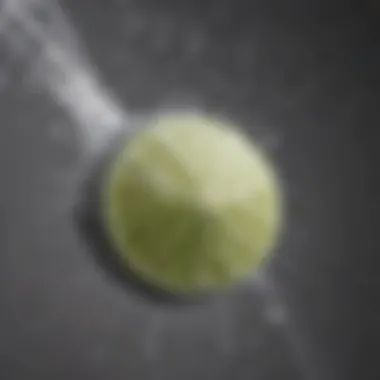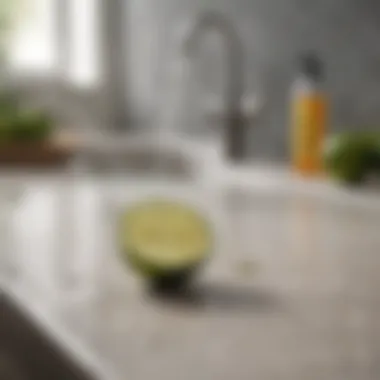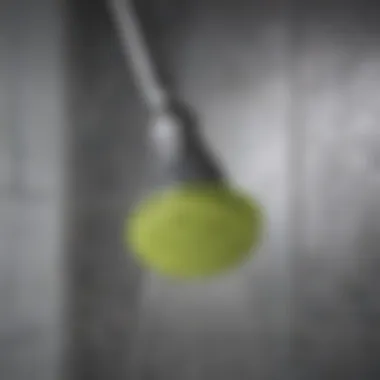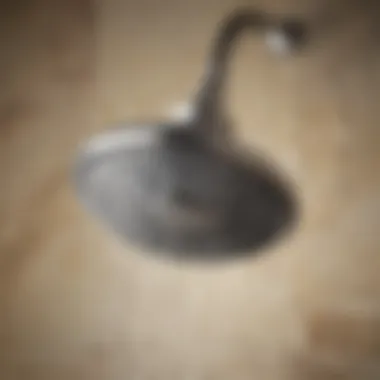Effective Methods for Removing Lime Scale from Shower Heads


Intro
Lime scale buildup in shower heads is a common problem, often resulting from hard water. This accumulation not only diminishes water flow but can also lead to unsanitary conditions. Over time, minerals like calcium and magnesium deposit in the nozzle holes, making it essential to address this issue. Effective cleaning methods are needed to restore functionality and hygiene. This article explores various techniques to combat lime scale, focusing on both chemical and natural solutions, as well as preventative measures to sustain cleanliness. With proper maintenance, one can enhance the longevity of shower fixtures and ensure a pleasant bathing experience without interruptions due to restricted water flow.
Causes of Lime Scale Accumulation
Understanding what leads to lime scale buildup is crucial for addressing it effectively. The primary cause is hard water, which contains high levels of minerals. Each time water flows through the shower head, some minerals are left behind as the water evaporates, leading to buildup over time. Other factors may include the temperature of the water and the frequency of use, which can speed up mineral deposits.
Impact of Lime Scale
The presence of lime scale has several negative effects:
- Reduced Water Flow: Lime scale can significantly decrease water pressure.
- Hygiene Concerns: Bacteria and mold can thrive in the unusual crevices created by mineral deposits, leading to potential health risks.
- Aesthetic Issues: Shower heads can appear dirty and unkempt, detracting from the overall look of the bathroom.
Addressing these issues requires a careful approach to both cleaning and prevention.
Understanding Lime Scale in Shower Heads
Lime scale in shower heads is a significant issue for many households. Understanding this problem is the first step towards effective removal and long-term prevention. Lime scale is primarily formed from minerals, especially calcium and magnesium, that occur in hard water. This understanding allows homeowners to be more mindful of their water quality and the impact it has on fixtures.
Once lime scale starts accumulating, it can lead to several problems, including reduced water flow, increased energy consumption, and even damage to plumbing systems. By knowing the formation and sources of lime scale, steps can be taken to mitigate these negative effects.
Formation of Lime Scale
Lime scale develops when hard water evaporates, leaving behind mineral deposits. The process usually starts when water with a high mineral content passes through shower heads. Over time, the minerals crystallize and create a hard, chalky residue. This buildup not only clogs the tiny openings of shower heads but can also create uneven water flow.
Common Sources of Hard Water
Several common sources contribute to hard water and consequently, lime scale formation in shower heads. These include:
- Well water, which often contains high levels of minerals.
- Municipal water supplies with high mineral content.
- Geographical areas with limestone or chalk formations in the earth.
Regularly checking local water reports can help identify the hardness of your water and take proactive measures.
Effects of Lime Scale on Shower Functionality
Lime scale not only affects the aesthetics of shower heads but also considerably impairs functionality. The reduction in water flow can lead to an unsatisfactory showering experience. Additionally, buildup can harbor bacteria and become a hygiene concern. Regular maintenance is essential to ensure that shower heads work efficiently, maintaining both water pressure and overall hygiene.
Understanding lime scale provides a foundation for effective cleaning, helping to ensure a fully operational shower system.
Chemical Cleaning Solutions
In the battle against lime scale buildup, chemical cleaning solutions often play a pivotal role. These methods leverage the properties of specific substances to dissolve and remove calcium carbonate deposits that can accumulate in shower heads. Chemical solutions are significant not only for their effectiveness but also for the time they save compared to more labor-intensive methods. Using them appropriately can restore water flow and improve the overall functionality of your shower head. However, careful consideration of these products is essential due to potential risks associated with their use.
Acetic Acid: Using Vinegar for Cleaning
One of the most accessible and popular chemical alternatives is vinegar, which contains acetic acid. Acetic acid is widely recognized for its ability to dissolve mineral deposits effectively. To clean a shower head with vinegar, one can simply submerge it in a bowl filled with white vinegar for several hours. This soaking allows the acetic acid to penetrate and break down the lime scale. After soaking, rinsing the shower head thoroughly with water is necessary to remove any residual vinegar, leaving it free of scale and ready for use.
To maximize the benefits of vinegar:


- Use white vinegar instead of apple cider vinegar, as it is more effective.
- If direct soaking is not possible, you may fill a plastic bag with vinegar and secure it around the shower head using a rubber band.
- Let it sit for at least an hour for better results.
Commercial Descalers: Varieties and Effectiveness
Another category of chemical cleaning solutions includes commercial descalers. These are specifically formulated products designed to tackle lime scale and other mineral deposits. They often come in liquid, gel, or powder form, and can be found in various brands, such as CLR or Lime-A-Way. Each product may contain different active ingredients, including phosphoric acid, sulfamic acid, or citric acid, which are all effective against scaling.
Understanding the variety of commercial descalers can help you choose the right one:
- Liquid descalers often flow easily into shower heads and pipes, making them easy to apply.
- Gel products may offer better cling on vertical surfaces, providing targeted cleaning action.
- Powders might require mixing with water but can be highly effective for tough buildups.
It is crucial to follow the manufacturer’s instructions for use, as improper application may lead to damage to the shower head or surrounding fixtures.
Safety Precautions When Using Chemicals
When utilizing any chemical cleaning solution, especially commercial products, safety precautions must be a priority. The use of strong acids and other chemicals requires a clear understanding of their potential hazards. Here are some essential points to consider:
- Wear protective gear such as gloves and goggles to safeguard against chemical splashes.
- Ensure adequate ventilation in the cleaning area to avoid inhaling fumes, which can be harmful.
- Store chemicals in a safe place, out of reach of children and pets.
- Always read the product label for specific instructions and warnings.
"Chemical cleaning solutions can be potent allies in maintaining shower cleanliness, but they require careful handling to ensure safety and effectiveness."
By observing these precautions, you can effectively use chemical cleaning solutions while minimizing health risks and ensuring a clean shower head.
Natural Cleaning Solutions
Natural cleaning solutions offer a safe and eco-friendly alternative to harsher chemical cleaners. These methods often employ common household ingredients that effectively tackle lime scale without the risks associated with synthetic products. In this article, we look closely at the benefits, effectiveness, and considerations surrounding natural cleaning solutions for lime removal.
Using natural cleaning agents not only reduces exposure to potentially harmful chemicals but also minimizes environmental impact. These options are often non-toxic, making them a suitable choice for households with children and pets. Furthermore, many natural methods are cost-effective, utilizing items readily available in your kitchen.
Baking Soda as a Gentle Abrasive
Baking soda serves as an effective gentle abrasive for cleaning lime scale. Its mildly gritty texture helps to scrub away deposits without scratching the surface of your shower head. To utilize this method, you can make a paste by mixing baking soda with water, applying it directly to the affected areas. Let it sit for about 15 to 20 minutes to give it time to penetrate the scale.
Afterward, use a soft cloth or sponge to scrub the shower head in circular motions. Rinse thoroughly with warm water. This process not only helps in removing lime scale but also can eliminate odors, leaving your shower fresh.
Citric Acid: An Effective Alternative
Citric acid, a natural compound found in citrus fruits, has excellent descaling properties. It works by breaking down mineral deposits through its acidic nature. To use citric acid for lime scale removal, dissolve a few tablespoons in warm water and soak the shower head in this solution for at least 30 minutes.
After soaking, scrub gently with a cloth or soft brush. Rinse with clean water to remove any residue. The benefits of using citric acid include its biodegradability and pleasant scent, making it an appealing choice for those sensitive to harsh chemicals.
Hydrogen Peroxide: Versatile Cleaning Agent
Hydrogen peroxide is a versatile substance known for its disinfectant properties. It can also effectively tackle lime scale buildup. To clean with hydrogen peroxide, spray or apply it directly to the affected areas and let it sit for about 10 to 15 minutes because this allows the solution to penetrate and loosen the deposits.
Afterward, scrub the area gently with a cloth before rinsing thoroughly. Hydrogen peroxide not only helps to eliminate lime scale but also disinfects surfaces, contributing to overall cleanliness in your shower. While generally safe to use, ensure good ventilation as the smell may be strong for some people.
Using natural cleaning solutions can profoundly impact the cleanliness and maintenance of your shower heads, ensuring long-term functionality and hygiene.
By implementing these natural cleaning methods, not only can you efficiently maintain the cleanliness of your shower heads, but you also contribute to a healthier home environment and reduce reliance on chemical cleaners.


Practical Cleaning Techniques
Cleaning lime scale from shower heads is essential for both aesthetic and functional reasons. Lime scale can restrict water flow, making your daily shower experience less satisfying. Effective cleaning techniques can prevent more significant issues with water pressure and can prolong the life of your shower fixture. This section highlights various practical methods that yield results and ensures a cleaner, healthier shower environment.
Soaking Methods for Effective Removal
Soaking is one of the simplest and most effective methods to combat lime scale. The process involves immersing the entire shower head or parts of it in a cleaning solution. Vinegar is commonly used due to its acetic acid content, which gently dissolves mineral deposits without damaging the surface. Here’s a basic method:
- Prepare the Solution: Use a bowl or bucket to mix equal parts of water and white vinegar.
- Remove the Shower Head: Detach the shower head from its mount.
- Soak: Fully immerse the shower head in the solution for at least 30 minutes, but for severe build-up, a longer soak may be necessary.
- Rinse and Examine: After soaking, rinse with warm water and check for remaining deposits. Repeat if necessary.
Using soaking methods can effectively break down the stubborn lime scale.
Scrubbing Techniques and Tools
After soaking, some residues might still be present. This is where scrubbing techniques come into play. Using the right tools can make a substantial difference. For effective scrubbing, consider the following:
- Tools: Soft-bristle brushes or old toothbrushes are ideal. They can clean hard-to-reach areas without scratching the surface. Avoid steel wool or abrasive pads, as these may damage the finish.
- Cleaning Paste: For tough deposits, creating a paste with baking soda and water can add some abrasion. Apply the paste onto the shower head and scrub gently.
Following these steps can significantly improve the cleanliness of the shower head, restoring its functionality and visual appeal.
Flushing Out Residue and Buildup
Flushing out is the final step in the cleaning regimen and is crucial for maintenance. After cleaning, it ensures that any cleaning solutions and loosened deposits are fully removed. Here’s a straightforward process:
- Reconnect the Shower Head: Once you are sure the cleaning process was sufficient, reattach the shower head to its mount.
- Run the Water: Turn the shower on to let the water run for several minutes. This action will flush out any remaining vinegar, baking soda, or residue that might linger after the cleaning process.
- Inspect: Take a moment to look at the water flow. It should be smooth and steady without any interruptions.
Implementing these flushing techniques can complete the cleaning process, making sure the shower head is not only clean but also fully functional.
Maintaining a clean shower head is not just about aesthetics but is crucial for ensuring efficient water flow and hygiene. Regular cleaning can save both time and money in the long run.
Preventative Measures
Preventative measures serve as the foundation for maintaining a clean and functional shower head. By implementing strategies aimed at reducing lime scale buildup, users can prolong the life of their shower fixtures and ensure optimal water flow. Understanding these methods allows users to avoid common pitfalls related to hard water, ultimately leading to better hygiene and a more pleasant bathing experience.
Water Softening Solutions
Water softeners act as an essential tool in mitigating the effects of hard water. Ion-exchange systems are particularly popular, replacing calcium and magnesium ions in hard water with sodium or potassium ions. This change reduces the tendency for lime scale to form. In addition, salt-free water conditioners are an alternative that can prevent scale without actually softening the water. It’s important to choose a solution that matches one's household needs, considering the local water hardness levels.
"Using water softeners can significantly reduce the occurrence of lime scale, protecting your shower head and enhancing water quality."
Another consideration is the installation of shower filters. Shower filters help in removing impurities and minerals, further contributing to a reduction in scale formation. Regularly changing or cleaning these filters is crucial to maintain their effectiveness.
Regular Maintenance Routines
Establishing a routine for cleaning shower heads will contribute significantly to preventing lime scale buildup. Schedule a cleaning session at least once a month. This can involve simple methods such as:
- Vinegar soaks: Submerge the shower head in a solution of vinegar and water to dissolve minor build-up.
- Wipe down: Regularly wiping the exterior with a damp cloth can prevent mineral deposits from accumulating.
Moreover, inspect the shower head for signs of lime scale and replace older fixtures if necessary. Keeping an eye on water quality and timing can prevent larger cleaning efforts later. Simple maintenance tasks, such as checking for leaks, also contribute to overall hygiene.


Selecting the Right Shower Head
When selecting a shower head, it is advisable to consider models designed to resist mineral build-up. Low-flow shower heads are recommended not only for their water-saving properties but also because they can help in reducing the flow rate of water, which limits mineral deposit accumulation.
Additionally, look for anti-clog features or materials that resist scale buildup. Some manufacturers highlight designs that make them easier to clean or that include built-in descaling mechanisms. Investing time to research options can save time and effort in the long run.
Impact of Water Quality
Understanding the impact of water quality is crucial when addressing lime scale issues in shower heads. The characteristics of your water influence how much lime scale can accumulate over time. Not all water is equal; the presence of minerals determines the formation of scale.
Water with a high mineral content is often termed hard water. This type of water has a noticeable impact on cleaning tasks, leading to stubborn buildup in fixtures and appliances, affecting their functionality and efficiency. Regular exposure to hard water can significantly decrease the lifespan of plumbing fixtures.
Hard Water Identification
To effectively manage lime scale, first, it is vital to identify the presence of hard water. There are several signs that indicate how hard your water might be:
- Soap scum on surfaces: When using soap, excess residue may cling to the tub or shower walls.
- Cloudy dishes: If you notice that your glassware looks hazy even after washing, hard water could be the cause.
- Buildup around faucets: White or chalky deposits can appear where water pools or runs out.
Basic tests can be helpful. You can often acquire test strips that measure water hardness. Alternatively, the simple "glass test" involves filling a clear glass with water and adding a few drops of liquid soap. If the water does not create bubbles, it may indicate hard water.
Testing Techniques for Hard Water
Testing the water can help confirm suspicions regarding hardness. The following methods are commonly used:
- Test Strips: Easily available, these strips change color according to the hardness level.
- Water Testing Kits: These kits provide extensive analysis, showing mineral levels, pH balance, and other characteristics.
- Professional Testing: For a more comprehensive evaluation, consider hiring a water analysis service to assess your water quality thoroughly.
Each method has its merits, but a simple test strip is usually sufficient for general household needs.
Long-Term Solutions for Hard Water Issues
Addressing hard water issues is essential for preventing future lime scale buildup. Here are a few long-term solutions:
- Water Softening Systems: Units that remove calcium and magnesium ions can drastically reduce hardness levels in your water supply.
- Regular Maintenance: Scheduling periodic checks on your plumbing systems can help catch any premature buildup before they become problematic.
- Choosing the Right Detergents: Select soaps and detergents specially formulated for hard water. This choice can minimize soap scum and enhance cleanliness.
Implementing these solutions not only improves the life of your plumbing fixtures but also enhances overall water quality, creating a more pleasant shower experience.
"The quality of water significantly impacts both the performance of shower heads and the ease of cleaning them."
Concluding Remarks on Shower Head Care
In addresssing the care of shower heads, we uncover a crucial layer of not just cleanliness but also functionality. Regularly maintaining your shower head is more than a cosmetic chore; it impacts water flow, hygiene, and the overall bathing experience. Lime scale accumulation can significantly hamper water pressure and affect the efficacy of shower systems. Furthermore, keeping shower heads clean can save you money in the long run, as a well-maintained device is less likely to need replacement.
Commitment to Regular Cleaning
A steadfast commitment to regular cleaning can yield numerous benefits. By establishing a routine, you can prevent the tedious buildup of lime scale that often stems from hard water. It is advisable to incorporate cleaning into your regular household maintenance schedule. This will not only enhance the longevity of your shower head but also enhance your personal well-being.
- Set intervals for cleaning: It is wise to clean your shower head at least every three months. Adjust the frequency based on your local water quality.
- Incorporate effective methods: Whether through acetic acid solutions or natural alternatives, using proper cleaning techniques will yield better results.
- Stay aware of changes: If you notice a decrease in water pressure or a change in water quality, this may indicate cleaning is overdue.
"Regular cleaning ensures that your shower head remains at peak performance, providing you with optimal water flow and quality."
Going Beyond Aesthetic Appeal
While a clean shower head may look better, the significance extends beyond mere aesthetics. Effective cleanliness can influence health considerations, especially concerning water quality. Lime scale and mineral buildup can become breeding grounds for bacteria, which can impact health if not adequately addressed.
- Health implications: Microbial growth can lead to skin irritations or other health risks. By preventing lime scale formation, you also safeguard your health.
- Cost efficiency: Investing in the upkeep of your shower head reduces the chances of needing replacements frequently, thus minimizing costs.
- Emphasizing experience: A clean shower head provides a better shower experience. This improves overall satisfaction and comfort.
In summary, understanding the importance of the concluding remarks on shower head care encapsulates a commitment to cleanliness, health, and economic efficiency. Regular maintenance transcends the visual aspects and delves into enhancing daily living experiences.















